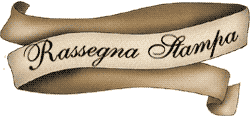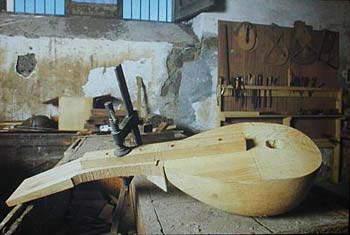

ARTIGIANI DEL SUONO
Mandolino
CRAFTSMEN OF SOUND
Mandoline
di Gianna Tangolo
Italiano per antonomasia, oltrechÚ per origini, il mandolino nasce nel 1500 ed e un diretto discendente della famiglia dei liuti, dei quali mantiene la linea sinuosa e piriforme.
L'esemplare pi¨ "classico" - il mandolino napoletano - Ŕ caratterizzato da un fondo molto convesso e da una tavola di risonanza dotata di un intaglio centrale e di una piastra di protezione in guscio di tartaruga che ha la funzione di preservare la tavola dall'azione del plettro.
Il manico e concluso da un cavigliere a spatola in cui sono infissi posteriormente i piroli.
Le quattro corde doppie sono sollevate da un ponticello incollato alla tavola armonica: il "tremolo", ossia la rapida e ripetuta azione del plettro sulle corde, costituisce una delle caratteristiche inconfondibili della sonoritÓ di questo strumento.
L'evoluzione del mandolino, a differenza di altri strumenti, non Ŕ legata a pßrticolari innovazioni della tecnica costruttiva. Si differenziano da quello napoletano, il mandolino milanese o mandurino, dotato di fondo poco convesso, con i piroli laterali e sei corde doppie che venivano pizzicate senza l'ausilio del plettro, cosi come altri modelli regionali - il siciliano, il genovese, il romano, etc., che ebbero diffusione di pi¨ modesta fortuna.
Alla stessa famiglia appartengono inoltre l'arcimandola, un mandolino basso del Settecento lungo circa un metro, e quello doppio, con due manici, costruito nel XIX secolo.
Il mandolino si diffonde anche all'estero, nella seconda metÓ del Settecento, ma deve la maggior fortuna alla popolaritÓ in Italia meridionale: strumento dalla sonoritÓ limitata, era solito accompagnare le serenate degli innamorati, e in questa veste "galeotta" venne impiegato da Mozart nel Don Giovanni.Italian by definition as well as in origin, the mandolin saw the light of day in 1500, a direct descendant of the lute family whose sinuous, pear-shaped line it retains.
The most classical type, the Neapolitan mandolin, has a convex back and a soundboard with centre hole and protective plate in tortoise-shell that protects the board from the action of the plectrum.
The neck ends with a flat finger board and rear-fitting pegs. The four double strings are held by a bridge glued to the soundboard: "tremolo", namely fast, repeated action of the plectrum on the strings, is one of the most typical features of the sound produced by this instrument.
Unlike other instruments, the mandolin's evolution was not linked to any particular innovation in constructional technique. The Milanese mandolin (or "mandurino") has a much less convex back with side pegs and six double strings that are plucked without the use of a plectrum, as are other regional models, the Sicilian, the Genovese, the Roman, etc. which have not become so popular.
Among instruments in the same family we might mention the "arcimandola", a bass mandolin of the eighteenth century about a meter long, and the double mandolin with its two necks, built in the nineteenth century.
The mandolin was exported in the second half of the eighteenth century but it achieved its greatest popularity in Southern Italy: an instrument of limited resonance, it was used to accompany lovers' serenades and in this "rogueish" guise it was used by Mozart in Don Giovanni.
La caratteristica forma dei mandolino, Ŕ ottenuta mediante l'impiego di una sagoma diversa a seconda dei modelli.
Different moulds are used to give the various models their typical mandolin shape.

Una guida posta al centro della sagoma consente la collocazione del manico nella esatta posizione.
A slide at the centre of the mouid makes it possible to set the neck at the right position
Con l'ausilio di un tubo metallico scaldato a fuoco vengono piegati i listelli di legno che formeranno il fondo della cassa armonica.
A metal tube is heated internally to bend the strips of wood that form the back of the soundbox.

I listelli possono essere in palissandro, come nella foto, o acero o ancora altri legni pregiati: da uno spessore massimo di 1 cm. nella parte centrale si rastremano alle estremitÓ fino ai pochi millimetri in prossimitÓ del manico. Essi vengono incollati tra loro e sulla carta che riveste la sagoma: questa operazione garantirÓ la perfetta coesione e la omogeneitÓ del guscio.
The strips are made of rosewood, as in the photograph, or maple-wood or other fine woods. They taper from a thickness of 1 cm. to only a few millimetres at the edges round the base of the neck. They are stuck together and to the paper which covers the mould. The body is thus totally cohesive and even.
La tavola armonica in abete Ŕ costituita da due parti simmetriche unite tra loro e piegate a caldo a formare un angolo ottuso; tre catene irrigidiscono la struttura.
The firwood soundbox is made of two symmetrical pieces joined together and tempered to an obtuse angle. Three chains reinforce the frame.Estratta la forma interna, la tavola armonica viene incollata al guscio, garantendo l'incastro con le estremitÓ delle catene.
The mould is removed and the soundboard glued to the body to fix the joim with the ends of the chain.Un sistema di morse assicura la perfetta aderenza delle parti del mandolino - senza alterare o comprimere la curvatura del guscio - fino ad incollaggio avvenuto.
A system of vices ensures the perfect adherence of the various parts of the mandolin, without altering the curve on the body, until glueing.Un'ultima fascia laterale viene apposta allo strumento per coprire la giunzione tra guscio e tavola armonica; la intera struttura viene quindi rifinita e carteggiata.
A side band is finally fixed to the instrument to cover the joint between the body and the soundboard. The entire structure is then finished and sanded.Uno "scudo" in tartaruga, celluloide o madreperla protegge e abbellisce la tavola armonica nella quale viene intagliato il foro di risonanza dopo la verniciatura.
A shield of tortoise-shell, celluloid or mother-of-pearl protects and embellishes the soundboard. After varnishing, a resonance hole is cut into the soundboard.Lo strumento finito. In questo caso un mandolino romano; la tastiera avanza fino a coprire il foro di risonanza.
The finished instrument, here a Roman mandolin. The finger board descends to cover the resonance hole.Artigiani del suono - Ricordi - Milano - 1988